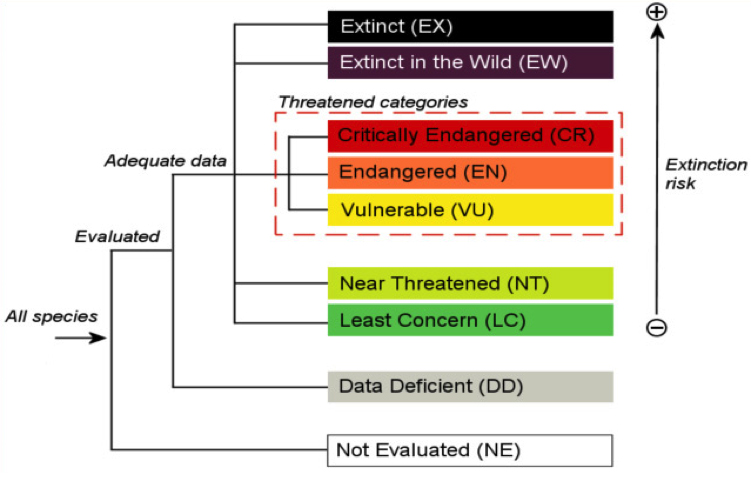CSG Red List AuthorityThe IUCN Red List of Threatened Species provides a standardised platform for evaluating the “risk of extinction” for all plant, animal and invertebrate species. The “risk of extinction” is expressed by classifying each species into one of 9 categories (Extinct, Extinct in the Wild, Critically Endangered, Endangered, Vulnerable, Near Threatened, Least Concern, Data Deficient, Not Evaluated; see Fig. 1). Identifying those species to be listed in the threatened categories - that is, either Critically Endangered (CR), Endangered (EN) or Vulnerable (VU) - is the primary purpose of the Red List process. The Crocodile Specialist Group is responsible for assessing the extinction risk for all crocodilian species.
Figure 1. Categories used by the IUCN Red List to express a species' "risk of extinction" (courtesy of IUCN 2012. IUCN Red List Categories and Criteria: Version 3.1. Second edition. Gland, Switzerland).
A. Declining population (measured over 3 generations) – most applicable to crocodilian assessments B. Restricted geographic range size and fragmentation C. Small population size and decline – applicable to highly threatened crocodilian species D. Very small population or restricted distribution E. Quantitative analysis of extinction risk
All crocodilians have had Red List assessments conducted, and no modern crocodilian fits into the Extinct (EX) or Extinct in the Wild (EW) categories. Of the extant crocodilians, 7 species are listed as Critically Endangered (CR), 5 as Vulnerable (VU), 11 as Least Concern (LC), and one (Crocodylus suchus) is in the process of being evaluated for inclusion in the Red List. A list of crocodilian species and their Red Listing can be found on the Conservation Status page. Red List process within the CSG
The final authority for Red Listing crocodilians lies with the CSG Chairman operating with the CSG Steering Committee. The Chairman has designated Dr. Sally Isberg (since May 2016) to be the Red List Authority (RLA) focal point and coordinate the CSG's internal process. In consultation with the Chair and Steering Committee, the RLA focal point proposes small groups of assessors who generate the raw material of each species assessment. Each assessment is then independently reviewed by 2-3 experts additional to the assessors. Following approval by the Chair, reviewed assessments are passed to SSC Red List staff for final review before passing into the publication stream.
Contributing to Red List assessments
The CSG RLA are always happy to receive assistance in conducting Red List assessments, which can now be added to your CV as a publication for added incentive. Survey and population data are always gratefully received, and with due acknowledgement to all contributors, the data will be added to the database for use in applying categories and criteria and creating species distribution maps at the next assessment. It should be noted that only breeding or adult individuals can be included in Red List assessments and ask those to be mindful of this when collecting survey data where possible. If you would like to make communicate with the CSG RLA, please contact us.
Finding crocodilian Red List assessments
Red List assessments for all crocodilian species can be found on the IUCN Red List website and searching for the species of interest. Individual species assessments can also be viewed at Conversation Status under the latest assessment year for each species.
Regional Red List assessments
Red List assessments are conducted on a global scale, although regional assessments are being increasingly used by decision makers to develop their conservation priorities. Regional assessments are particularly useful for governments and other authorities developing strategic policies for particular species at the regional level.
|

 Email CSG
Email CSG
